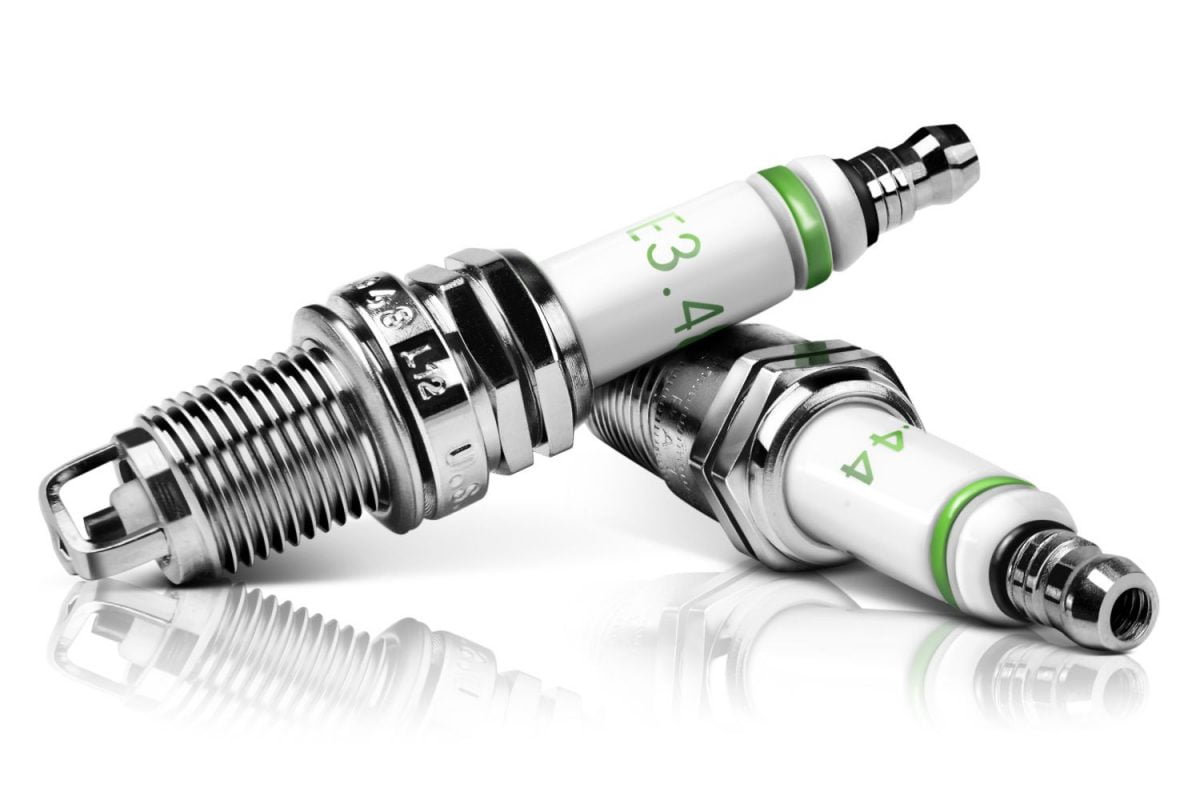The color of a motorcycle’s spark plug can give us many clues about the mechanical health of an engine. Let’s take a look at each of the problems that can affect the color of a spark plug..
Fever in humans is a symptom that something is wrong. As soon as we notice that our temperature rises, we run to the doctor or pharmacy to remedy something that affects us.
With our motorcycles the same thing happens, the spark plug is not usually the problem, however it is usually a great indicator of the health of our engine. It is therefore important to learn how to read the color of a motorcycle spark plug.
It is very easy to remove the spark plug to check its condition, so do not hesitate to do it once or twice a year. It is also necessary to change them every 25,000 km. It is one of the most basic motorcycle mechanics tasks that exist.
What is a spark plug used for?
Before studying the shades that a spark plug can have, let’s review what they are used for.
The spark plug (also called spark plug) is responsible for generating the spark that will explode the mixture of gasoline and air that has entered the cylinder through the carburetor or injector. When the mixture explodes, it moves the piston that starts the engine.
In addition to generating the spark, the spark plug is responsible for absorbing and dissipating the excess heat in the combustion chamber, at its ideal temperature.
By the way, diesel engines do not have spark plugs, only gasoline engines (they can have glow plugs but they do not have the same operation).
What does the thermal rating of a spark plug indicate?
Not all engines are the same, some engines reach much higher temperatures than others.
A sports car, for example, has much higher requirements than a utility vehicle, and its engine reaches much higher temperatures.
The cool or low thermal grade spark plugs are used in very powerful, or higher performance engines, helping to dissipate such heat quickly.
On the contrary, less demanding engines need high thermal grade spark plugs, to dissipate heat more slowly.
What does the color of a motorcycle spark plug indicate?
Grayish white or light brown
If the base of the insulator (the white part) has a dirty white, yellowish or light brown color, the spark plug is functioning properly. This is the color that a motorcycle spark plug should have.
The engine is correctly calibrated, as well as the carburetion, and the spark plug heat rating is ideal.
It is also normal for the external electrode to have a whitish color.

Spark plug covered with dry black soot
Color: this is a common coloration when restoring an old motorcycle. The spark plug appears totally black, with a powdery residue, which disappears when wiped with a cloth.
Problem: we will have problems starting the bike when cold, which will fail at slow speed or idle. False explosions.
Causes:
- Mixture too rich in gasoline.
- The ignition timing may be retarded (the spark is produced when the piston is already down).
- The thermal grade is too cold.
- The air filter is dirty.
- The ignition voltage is not correct.
- The choke is not well regulated.
- The engine has been running at low rpm for a long time.

Gasoline wet spark plug.
Color: the spark plug is impregnated with gasoline.
Problem: the bike does not start well and, when it does, it does not run well in slow speed.
Causes:
- The motor is choked.
- Spark plug electrodes are too far apart or too close together. Spark does not jump.
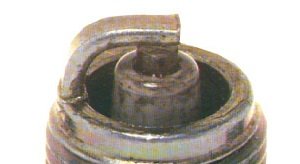
Spark plug with white, yellowish or reddish deposits.
Color: the spark plug appears to be oxidized or with colored residues (white, yellow, red, brown) covering it. They disappear when wiped with a cloth.
Problem: engine misfires at high rpm, loses power. The combustion of these particles can cause engine damage.
Causes:
- Check the quality of the gasoline, it may contain additives that are depositing on the spark plug.
- The oil may have impurities that do not burn.
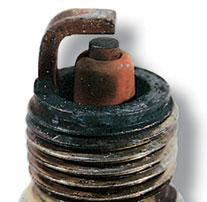
Black spark plug with wet look.
Color: unlike soot, it is a shiny, wet black that covers the electrodes.
Problem: we will have problems starting the bike, which will fail at slow speed or idle.
Causes: there is oil in the combustion chamber.
- The piston rings are not in good condition and the lubrication oil rises into the combustion chamber.
- Valve seals in bad condition.
- Cylinder in bad condition. It may be necessary to rectify it.
- If the engine is a two-stroke engine, excess oil in the mixture.
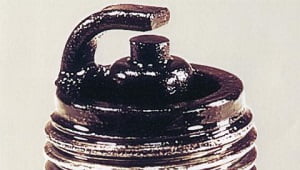
Glossy insulator spark plug with granules.
Color: the tip of the insulator is too bright, yellowish or light brown, with dark granules.
Problem: the engine fails when it is heavily loaded, when accelerating or climbing.
Causes: overheated spark plug.Causes: overheated spark plug.
- Advanced ignition: the spark jumps before the piston is fully raised.
- Poor mixture, with excess air vs. gasoline.
- Excessive heat rating spark plug.
- Overheated motor, which does not cool well.
- Low octane fuel.
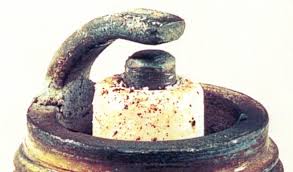
Bujía amarilla
Color: the tip of the insulator appears covered by a yellowish, brownish or even greenish layer. This is a lead film, which does not disappear when wiped with a cloth.
Problem: the engine misfires when it is heavily loaded, when accelerating or climbing. The spark plug was replaced 2,000 – 3,000 km ago.
Causes:
- Lead additives in the fuel. They have not been consumed by running the spark plug at part throttle. They must be replaced.

Bujía con ceniza
Color: it is not only black soot, but a thick layer of whitish or grayish ash.
Problem: false explosions and loss of power.
Causes:
- Oil components or additives generate ash that accumulates in the combustion chamber.

Electrodo central fundido
Appearance: the central electrode appears melted or semi-melted, with the insulator surrounding it softened or in bad condition. The spark plugs must be replaced.
Problem: misfiring and loss of power.
Causes:
- Incorrectly adjusted ignition (normally advanced).
- Combustion residues in the chamber.
- Valves in bad condition.
- Spark plug heat rating too high. Spark plug too hot.
- Fuel in poor condition or very poor mixture.
- Poorly tightened spark plug.

Molten electrodes
Appearance: the electrodes appear melted or badly worn.
Problems: Difficulty in starting and failure to accelerate.
Causes:
- Very aggressive additives in fuel or oil.
- Engine pitting.
- Deposits in the combustion chamber.
- Spark plug too hot.

Don’t know which spark plug your bike has?
If you are having problems with the spark plugs of your motorcycle, do not remember what the ideal spark plug was or want to know which is the recommended spark plug for your motorcycle, we leave you this manual in which come all the motorcycle models with their spark plugs.
These are the most common problems that we can find when analyzing the spark plug of our motorcycle. It is important to learn how to read the color of the spark plug of a motorcycle, to maintain the good health of our machines.

